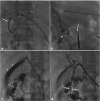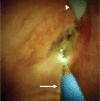Stepwise Percutaneous Approach to Treat Severe Benign Hepaticojejunostomy Stenosis
- PMID: 36406028
- PMCID: PMC9671672
- DOI: 10.1055/s-0042-1757343
Stepwise Percutaneous Approach to Treat Severe Benign Hepaticojejunostomy Stenosis
Conflict of interest statement
Conflict of Interest The authors would like to state that they do not have any conflict of interest.
Figures






Similar articles
-
Benign postoperative hepaticojejunostomy stricture: percutaneous recanalisation using the reverse end of a microwire.Clin Radiol. 2020 Nov;75(11):879.e1-879.e6. doi: 10.1016/j.crad.2020.06.029. Epub 2020 Jul 26. Clin Radiol. 2020. PMID: 32727657
-
Long-term follow-up of percutaneous transhepatic therapy (PTT) in patients with definite benign anastomotic strictures after hepaticojejunostomy.Endoscopy. 2001 May;33(5):409-15. doi: 10.1055/s-2001-14264. Endoscopy. 2001. PMID: 11396758 Clinical Trial.
-
Percutaneous balloon dilatation for benign hepaticojejunostomy strictures.Abdom Imaging. 2000 Mar-Apr;25(2):134-8. doi: 10.1007/s002619910032. Abdom Imaging. 2000. PMID: 10675453
-
Hepaticojejunostomy for bile duct injury: state of the art.Langenbecks Arch Surg. 2023 Feb 27;408(1):107. doi: 10.1007/s00423-023-02818-3. Langenbecks Arch Surg. 2023. PMID: 36843190 Review.
-
Leakage of Hepaticojejunal Anastomosis: Radiological Interventional Therapy.Visc Med. 2017 Jun;33(3):192-196. doi: 10.1159/000469476. Epub 2017 May 26. Visc Med. 2017. PMID: 28785566 Free PMC article. Review.
References
-
- Sanders R L. Hemihepatectomy with hepaticojejunostomy for irreparable defects of the bile ducts. Arch Surg. 1949;58(06):752–761. - PubMed
-
- Chok K S, Lo C M. Prevention and management of biliary anastomotic stricture in right-lobe living-donor liver transplantation. J Gastroenterol Hepatol. 2014;29(10):1756–1763. - PubMed

